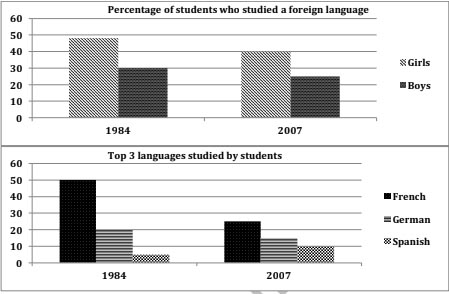The two bar charts show the proportion of 14-16-year-old students studying a modern foreign language in an English-speaking country and the top three popular foreign languages. Summarize the information by selecting and reporting the main features, and make comparisons where relevant. Write at least 150 words.

Bài mẫu
The charts delineate the proportion of male and female students in an English-speaking country who studied a foreign language between the ages of 14 and 16, and the three most popular languages they learned in 1984 and 2007.
It is evident that a higher percentage of females showed an inclination towards learning new languages compared to males in both years. Furthermore, French emerged as the predominant choice of language among students.
In 1984, approximately 50% of female students engaged in foreign language acquisition, in contrast to only 30% of males. By 2007, these figures saw a notable decline, with approximately 40% of female students continuing to study new languages, while only about 25% of male students pursued language learning.
Regarding language preferences, in 1984, French stood out as the top choice among second language learners. However, over the following years, its dominance dwindled, settling at approximately 25%, but French remained the preferred language for learners aged 14-16. Initially selected by 20% of learners, German followed a similar declining trajectory, albeit less steep than French, dropping to less than 15%. Conversely, Spanish gained popularity, experiencing a negligible rise from around 5% to 10% and remaining consistently the least favored option.
Từ vựng tốt trong bài
- delineate (v): vẽ (hình…); vạch (kế hoạch…); mô tả, phác hoạ
Giải thích: to describe or mark the edge of something
Ví dụ: The main characters are clearly delineated in the first chapter.
- show an inclination (v): xu hướng
Giải thích: tendency
Ví dụ: She shows an inclination towards learning new languages.
- predominant (adj): chiếm ưu thế, trội hơn hẳn
Giải thích: more noticeable or important, or larger in number, than others
Ví dụ: Dancers have a predominant role in this performance.
- language acquisition (n): tiếp nhận ngôn ngữ
Giải thích: the process by which humans acquire the ability to comprehend and produce language, either as their first or second (third, etc.) language
Ví dụ: Language acquisition becomes easier through immersion in a foreign culture.
- see a notable decline (v): sự suy giảm đáng kể
Giải thích: to observe a significant decrease in something
Ví dụ: After the new regulations were implemented, we saw a notable decline in air pollution levels.
- dwindle (v): giữ vị thế thống trị
Giải thích: to be in a leading or superior position.
Ví dụ: The company held the domina
- follow a similar declining trajectory (v): có một quỹ đạo giảm tương tự
Giải thích: to track a similar pattern of decline
Ví dụ: The stock prices of both companies follow a similar declining trajectory due to market uncertainties.
- albeit: mặc dù
Giải thích: although
Ví dụ: The evening was very pleasant, albeit a little quiet.
- negligible (adj): không đáng kể
Giải thích: too slight or small in amount to be of importance
Ví dụ: The difference between the two products is negligible.
Bạn đang chuẩn bị cho kì thi IELTS?
Hãy tham khảo Khóa Học IELTS Online qua ZOOM cùng cô Thanh Loan
IELTS Thanh Loan – giáo viên 10 năm kinh nghiệm – trực tiếp đứng lớp, tự tin mang đến khóa học chất lượng nhất, phương pháp giảng dạy cô đọng dễ hiểu, giáo trình tự biên soạn cho lộ trình từ cơ bản đến luyện đề chuyên sâu. Đặc biệt, học viên luôn được quan tâm sát sao nhất, hỗ trợ không giới hạn, thúc đẩy kỷ luật học tập tốt để đạt mục tiêu.

Lược dịch tiếng Việt
Các biểu đồ mô tả tỷ lệ học sinh nam và nữ ở một quốc gia nói tiếng Anh đã học ngoại ngữ trong độ tuổi từ 14 đến 16 và ba ngôn ngữ phổ biến nhất mà họ học vào năm 1984 và 2007.
Rõ ràng là tỷ lệ nữ giới có xu hướng học ngôn ngữ mới cao hơn so với nam giới trong cả hai năm. Hơn nữa, tiếng Pháp nổi lên là ngôn ngữ được sinh viên lựa chọn chủ yếu.
Năm 1984, khoảng 50% sinh viên nữ tham gia học ngoại ngữ, so với chỉ 30% nam sinh. Đến năm 2007, những con số này đã giảm đáng kể, với khoảng 40% sinh viên nữ tiếp tục học ngôn ngữ mới, trong khi chỉ có khoảng 25% sinh viên nam theo đuổi việc học ngôn ngữ.
Về sở thích ngôn ngữ, năm 1984, tiếng Pháp đứng đầu trong số những người học ngôn ngữ thứ hai. Tuy nhiên, trong những năm tiếp theo, sự thống trị của nó giảm dần, chỉ còn khoảng 25%, nhưng tiếng Pháp vẫn là ngôn ngữ ưa thích của người học từ 14-16 tuổi. Ban đầu được 20% người học lựa chọn, tiếng Đức cũng đi theo quỹ đạo giảm dần tương tự, mặc dù ít dốc hơn tiếng Pháp, giảm xuống dưới 15%. Ngược lại, tiếng Tây Ban Nha lại trở nên phổ biến, tăng không đáng kể từ khoảng 5% lên 10% và luôn là lựa chọn ít được ưa chuộng nhất.
Xem thêm:













